Identification of Target Proteins Involved in Cochlear Hair Cell Progenitor Cytotoxicity following Gentamicin Exposure
Abstract
1. Introduction
2. Materials and Methods
2.1. Cell Culture
2.2. Gentamicin Treatment
2.3. Sample Denaturation/Reduction/Alkylation
2.4. Sample Enzymatic Digestion
2.5. Desalting and Protein Enrichment
2.6. Data Analysis
2.7. Confocal Microscopy
2.8. Cleaved Caspase 3 Determination
2.9. Statistical Analysis
3. Results
3.1. Upregulated Proteins in Response to Gentamicin Ototoxicity in HEI-OC1 Cells
3.2. Common Target Proteins Upregulated Following Treatment of HEI-OC1 with Two Doses of Gentamicin
3.3. Sap30bp Immunostaining in HEI-OC1 via Confocal Microscopy
3.4. TAO1 Kinase Expression in HEI-OC1 via Confocal Microscopy
3.5. Cleaved Caspase 3 Determination
4. Discussion
Author Contributions
Funding
Institutional Review Board Statement
Informed Consent Statement
Data Availability Statement
Acknowledgments
Conflicts of Interest
References
- Haile, L.M.; Kamenov, K.; Briant, P.S.; Orji, A.U.; Steinmetz, J.D.; Abdoli, A.; Abdollahi, M.; Abu-Gharbieh, E.; Afshin, A.; Ahmed, H.; et al. Hearing loss prevalence and years lived with disability, 1990–2019: Findings from the Global Burden of Disease Study 2019. Lancet 2021, 397, 996–1009. [Google Scholar] [CrossRef]
- Shave, S.; Botti, C.; Kwong, K. Congenital Sensorineural Hearing Loss. Pediatr. Clin. N. Am. 2022, 69, 221–234. [Google Scholar] [CrossRef] [PubMed]
- Lin, F.R.; Niparko, J.K.; Ferrucci, L. Hearing loss prevalence in the United States. Arch. Intern. Med. 2011, 171, 1851–1852. [Google Scholar] [CrossRef]
- Powell, D.S.; Oh, E.S.; Reed, N.S.; Lin, F.R.; Deal, J.A. Hearing Loss and Cognition: What We Know and Where We Need to Go. Front. Aging Neurosci. 2021, 13, 769405. [Google Scholar] [CrossRef] [PubMed]
- Jiang, M.; Karasawa, T.; Steyger, P.S. Aminoglycoside-Induced Cochleotoxicity: A Review. Front. Cell. Neurosci. 2017, 11, 308. [Google Scholar] [CrossRef]
- Karpa, M.J.; Gopinath, B.; Beath, K.; Rochtchina, E.; Cumming, R.G.; Wang, J.J.; Mitchell, P. Associations between hearing impairment and mortality risk in older persons: The Blue Mountains Hearing Study. Ann. Epidemiol. 2010, 20, 452–459. [Google Scholar] [CrossRef]
- Bainbridge, K.E.; Hoffman, H.J.; Cowie, C.C. Diabetes and hearing impairment in the United States: Audiometric evidence from the National Health and Nutrition Examination Survey, 1999 to 2004. Ann. Intern. Med. 2008, 149, 1–10. [Google Scholar] [CrossRef]
- Joo, Y.; Cruickshanks, K.J.; Klein, B.E.K.; Klein, R.; Hong, O.; Wallhagen, M. Prevalence of ototoxic medication use among older adults in Beaver Dam, Wisconsin. J. Am. Assoc. Nurse Pract. 2018, 30, 27–34. [Google Scholar] [CrossRef]
- Brock, P.R. New insights into cisplatin ototoxicity. Cancer 2022, 128, 43–46. [Google Scholar] [CrossRef]
- Lanvers-Kaminsky, C.; Zehnhoff-Dinnesen, A.A.; Parfitt, R.; Ciarimboli, G. Drug-induced ototoxicity: Mechanisms, Pharmacogenetics, and protective strategies. Clin. Pharmacol. Ther. 2017, 101, 491–500. [Google Scholar] [CrossRef]
- Krause, K.M.; Serio, A.W.; Kane, T.R.; Connolly, L.E. Aminoglycosides: An Overview. Cold Spring Harb. Perspect. Med. 2016, 6, a027029. [Google Scholar] [CrossRef] [PubMed]
- Block, M.; Blanchard, D.L. Aminoglycosides. In StatPearls; StatPearls Publishing: Treasure Island, FL, USA, 2022. [Google Scholar]
- LiverTox, N. Clinical and Research Information on Drug-Induced Liver Injury; National Institute of Diabetes and Digestive and Kidney Diseases: Bethesda, MD, USA, 2012. [Google Scholar]
- Tadi, S.; Misra, S.K.; Sharp, J.S. Inline Liquid Chromatography-Fast Photochemical Oxidation of Proteins for Targeted Structural Analysis of Conformationally Heterogeneous Mixtures. Anal. Chem. 2021, 93, 3510–3516. [Google Scholar] [CrossRef] [PubMed]
- Aleman, M.R.; True, A.; Scalco, R.; Crowe, C.M.; Costa, L.R.R.; Chigerwe, M. Gentamicin-induced sensorineural auditory loss in healthy adult horses. J. Vet. Intern. Med. 2021, 35, 2486–2494. [Google Scholar] [CrossRef] [PubMed]
- Forge, A.; Schacht, J. Aminoglycoside antibiotics. Audiol. Neurootol. 2000, 5, 3–22. [Google Scholar] [CrossRef]
- Steyger, P.S. Mechanisms of Aminoglycoside- and Cisplatin-Induced Ototoxicity. Am. J. Audiol. 2021, 30, 887–900. [Google Scholar] [CrossRef]
- Kovacic, P.; Somanathan, R. Ototoxicity and noise trauma: Electron transfer, reactive oxygen species, cell signaling, electrical effects, and protection by antioxidants: Practical medical aspects. Med. Hypotheses 2008, 70, 914–923. [Google Scholar] [CrossRef]
- Kurabi, A.; Keithley, E.M.; Housley, G.D.; Ryan, A.F.; Wong, A.C. Cellular mechanisms of noise-induced hearing loss. Hear. Res. 2017, 349, 129–137. [Google Scholar] [CrossRef]
- Matsui, J.I.; Ogilvie, J.M.; Warchol, M.E. Inhibition of caspases prevents ototoxic and ongoing hair cell death. J. Neurosci. 2002, 22, 1218–1227. [Google Scholar] [CrossRef]
- Wiedenhoft, H.; Hayashi, L.; Coffin, A.B. PI3K and Inhibitor of Apoptosis Proteins Modulate Gentamicin- Induced Hair Cell Death in the Zebrafish Lateral Line. Front. Cell. Neurosci. 2017, 11, 326. [Google Scholar] [CrossRef]
- Ding, D.; He, J.; Allman, B.L.; Yu, D.; Jiang, H.; Seigel, G.M.; Salvi, R.J. Cisplatin ototoxicity in rat cochlear organotypic cultures. Hear. Res. 2011, 282, 196–203. [Google Scholar] [CrossRef]
- Liu, Y.; Wei, M.; Mao, X.; Chen, T.; Lin, P.; Wang, W. Key Signaling Pathways Regulate the Development and Survival of Auditory Hair Cells. Neural Plast. 2021, 2021, 5522717. [Google Scholar] [CrossRef] [PubMed]
- Tao, L.; Segil, N. Early transcriptional response to aminoglycoside antibiotic suggests alternate pathways leading to apoptosis in sensory hair cells in the mouse inner ear. Front. Cell. Neurosci. 2015, 9, 190. [Google Scholar] [CrossRef] [PubMed]
- Karasawa, T.; Steyger, P.S. Intracellular mechanisms of aminoglycoside-induced cytotoxicity. Integr. Biol. (Camb.) 2011, 3, 879–886. [Google Scholar] [CrossRef]
- Cravatt, B.F.; Simon, G.M.; Yates, J.R., 3rd. The biological impact of mass-spectrometry-based proteomics. Nature 2007, 450, 991–1000. [Google Scholar] [CrossRef] [PubMed]
- Vanderboom, P.M.; Dasari, S.; Ruegsegger, G.N.; Pataky, M.W.; Lucien, F.; Heppelmann, C.J.; Lanza, I.R.; Nair, K.S. A size-exclusion-based approach for purifying extracellular vesicles from human plasma. Cell Rep. Methods 2021, 1, 100055. [Google Scholar] [CrossRef]
- Leong, S.; Christopherson, R.I.; Baxter, R.C. Profiling of apoptotic changes in human breast cancer cells using SELDI-TOF mass spectrometry. Cell. Physiol. Biochem. 2007, 20, 579–590. [Google Scholar] [CrossRef]
- Thomas, R.L., Jr.; Matsko, C.M.; Lotze, M.T.; Amoscato, A.A. Mass spectrometric identification of increased C16 ceramide levels during apoptosis. J. Biol. Chem. 1999, 274, 30580–30588. [Google Scholar] [CrossRef]
- Carpena, N.T.; Chang, S.Y.; Abueva, C.D.G.; Jung, J.Y.; Lee, M.Y. Differentiation of embryonic stem cells into a putative hair cell-progenitor cells via co-culture with HEI-OC1 cells. Sci. Rep. 2021, 11, 13893. [Google Scholar] [CrossRef]
- Kalinec, G.M.; Webster, P.; Lim, D.J.; Kalinec, F. A cochlear cell line as an in vitro system for drug ototoxicity screening. Audiol. Neurootol. 2003, 8, 177–189. [Google Scholar] [CrossRef]
- Kalinec, G.M.; Cohn, W.; Whitelegge, J.P.; Faull, K.F.; Kalinec, F. Preliminary Characterization of Extracellular Vesicles From Auditory HEI-OC1 Cells. Ann. Otol. Rhinol. Laryngol. 2019, 128, 52S–60S. [Google Scholar] [CrossRef]
- Park, C.; Thein, P.; Kalinec, G.; Kalinec, F. HEI-OC1 cells as a model for investigating prestin function. Hear. Res. 2016, 335, 9–17. [Google Scholar] [CrossRef] [PubMed]
- Zhao, J.; Liu, H.; Huang, Z.; Yang, R.; Gong, L. The Ameliorative Effect of JNK Inhibitor D-JNKI-1 on Neomycin-Induced Apoptosis in HEI-OC1 Cells. Front. Mol. Neurosci. 2022, 15, 824762. [Google Scholar] [CrossRef] [PubMed]
- Zhou, M.; Sun, G.; Zhang, L.; Zhang, G.; Yang, Q.; Yin, H.; Li, H.; Liu, W.; Bai, X.; Li, J.; et al. STK33 alleviates gentamicin-induced ototoxicity in cochlear hair cells and House Ear Institute-Organ of Corti 1 cells. J. Cell. Mol. Med. 2018, 22, 5286–5299. [Google Scholar] [CrossRef] [PubMed]
- Dong, Y.; Liu, D.; Hu, Y.; Ma, X. NaHS Protects Cochlear Hair Cells from Gentamicin-Induced Ototoxicity by Inhibiting the Mitochondrial Apoptosis Pathway. PLoS ONE 2015, 10, e0136051. [Google Scholar] [CrossRef]
- Orsburn, B.C. Proteome Discoverer-A Community Enhanced Data Processing Suite for Protein Informatics. Proteomes 2021, 9, 15. [Google Scholar] [CrossRef]
- Amin, B.; Robinson, R.A.S. Dataset of quantitative proteomic analysis to understand aging processes in rabbit liver. Data Brief. 2020, 31, 105701. [Google Scholar] [CrossRef]
- Arcuri, J.; Veldman, M.B.; Bhattacharya, S.K. Lipidomics dataset of Danio rerio optic nerve regeneration model. Data Brief. 2021, 37, 107260. [Google Scholar] [CrossRef]
- Memis, I.; Mittal, R.; Furar, E.; White, I.; Eshraghi, R.S.; Eshraghi, A.A. Altered Blood Brain Barrier Permeability and Oxidative Stress in Cntnap2 Knockout Rat Model. J. Clin. Med. 2022, 11, 2725. [Google Scholar] [CrossRef]
- Shah, V.; Mittal, R.; Shahal, D.; Sinha, P.; Bulut, E.; Mittal, J.; Eshraghi, A.A. Evaluating the Efficacy of Taurodeoxycholic Acid in Providing Otoprotection Using an in vitro Model of Electrode Insertion Trauma. Front. Mol. Neurosci. 2020, 13, 113. [Google Scholar] [CrossRef]
- Eshraghi, A.A.; Shahal, D.; Davies, C.; Mittal, J.; Shah, V.; Bulut, E.; Garnham, C.; Sinha, P.; Mishra, D.; Marwede, H.; et al. Evaluating the Efficacy of L-N-acetylcysteine and Dexamethasone in Combination to Provide Otoprotection for Electrode Insertion Trauma. J. Clin. Med. 2020, 9, 716. [Google Scholar] [CrossRef]
- Chao, M.W.; Lin, T.E.; HuangFu, W.C.; Chang, C.D.; Tu, H.J.; Chen, L.C.; Yen, S.C.; Sung, T.Y.; Huang, W.J.; Yang, C.R.; et al. Identification of a dual TAOK1 and MAP4K5 inhibitor using a structure-based virtual screening approach. J. Enzyme Inhib. Med. Chem. 2021, 36, 98–108. [Google Scholar] [CrossRef]
- Feldman, H.M.; Toledo, C.M.; Arora, S.; Hoellerbauer, P.; Corrin, P.; Carter, L.; Kufeld, M.; Bolouri, H.; Basom, R.; Delrow, J. CRISPR-Cas9 Screens Reveal Genes Regulating a G0-like State in Human Neural Progenitors. 2018. Available online: https://ssrn.com/abstract=3219283 (accessed on 25 May 2022).
- Wu, M.F.; Wang, S.G. Human TAO kinase 1 induces apoptosis in SH-SY5Y cells. Cell Biol. Int. 2008, 32, 151–156. [Google Scholar] [CrossRef]
- Zihni, C.; Mitsopoulos, C.; Tavares, I.A.; Ridley, A.J.; Morris, J.D. Prostate-derived sterile 20-like kinase 2 (PSK2) regulates apoptotic morphology via C-Jun N-terminal kinase and Rho kinase-1. J. Biol. Chem. 2006, 281, 7317–7323. [Google Scholar] [CrossRef] [PubMed]
- Karasawa, T.; Wang, Q.; David, L.L.; Steyger, P.S. Calreticulin binds to gentamicin and reduces drug-induced ototoxicity. Toxicol. Sci. 2011, 124, 378–387. [Google Scholar] [CrossRef] [PubMed][Green Version]
- Tian, B.; Kang, X.; Zhang, L.; Zheng, J.; Zhao, Z. SAP30BP gene is associated with the susceptibility of rotator cuff tear: A case-control study based on Han Chinese population. J. Orthop. Surg. Res. 2020, 15, 356. [Google Scholar] [CrossRef] [PubMed]
- Nagy, L.; Kao, H.Y.; Chakravarti, D.; Lin, R.J.; Hassig, C.A.; Ayer, D.E.; Schreiber, S.L.; Evans, R.M. Nuclear receptor repression mediated by a complex containing SMRT, mSin3A, and histone deacetylase. Cell 1997, 89, 373–380. [Google Scholar] [CrossRef]
- Alland, L.; Muhle, R.; Hou, H., Jr.; Potes, J.; Chin, L.; Schreiber-Agus, N.; DePinho, R.A. Role for N-CoR and histone deacetylase in Sin3-mediated transcriptional repression. Nature 1997, 387, 49–55. [Google Scholar] [CrossRef]
- Zhang, Y.; Sun, Z.-W.; Iratni, R.; Erdjument-Bromage, H.; Tempst, P.; Hampsey, M.; Reinberg, D. SAP30, a Novel Protein Conserved between Human and Yeast, Is a Component of a Histone Deacetylase Complex. Mol. Cell 1998, 1, 1021–1031. [Google Scholar] [CrossRef]
- Li, J.F.; Liu, L.D.; Ma, S.H.; Che, Y.C.; Wang, L.C.; Dong, C.H.; Zhao, H.L.; Liao, Y.; Li, Q.H. HTRP--an immediate-early gene product induced by HSV1 infection in human embryo fibroblasts, is involved in cellular co-repressors. J. Biochem. 2004, 136, 169–176. [Google Scholar] [CrossRef]
- Tashjian, R.Z.; Granger, E.K.; Farnham, J.M.; Cannon-Albright, L.A.; Teerlink, C.C. Genome-wide association study for rotator cuff tears identifies two significant single-nucleotide polymorphisms. J. Shoulder Elbow Surg. 2016, 25, 174–179. [Google Scholar] [CrossRef]
- Nicotera, T.M.; Hu, B.H.; Henderson, D. The caspase pathway in noise-induced apoptosis of the chinchilla cochlea. J. Assoc. Res. Otolaryngol 2003, 4, 466–477. [Google Scholar] [CrossRef] [PubMed]
- Cunningham, L.L.; Cheng, A.G.; Rubel, E.W. Caspase activation in hair cells of the mouse utricle exposed to neomycin. J. Neurosci. 2002, 22, 8532–8540. [Google Scholar] [CrossRef] [PubMed]
- Ding, D.; Jiang, H.; Salvi, R.J. Mechanisms of rapid sensory hair-cell death following co-administration of gentamicin and ethacrynic acid. Hear. Res. 2010, 259, 16–23. [Google Scholar] [CrossRef] [PubMed]
- Kaiser, C.L.; Chapman, B.J.; Guidi, J.L.; Terry, C.E.; Mangiardi, D.A.; Cotanche, D.A. Comparison of activated caspase detection methods in the gentamicin-treated chick cochlea. Hear. Res. 2008, 240, 1–11. [Google Scholar] [CrossRef]
- Ferreira, C.R.; Pirro, V.; Jarmusch, A.K.; Alfaro, C.M.; Cooks, R.G. Ambient Lipidomic Analysis of Single Mammalian Oocytes and Preimplantation Embryos Using Desorption Electrospray Ionization (DESI) Mass Spectrometry. Methods Mol. Biol. 2020, 2064, 159–179. [Google Scholar] [CrossRef]
- Chavant, A.; Jourdil, J.F.; Jouve, T.; Christians, U.; Fonrose, X.; Stanke-Labesque, F. A simple and easy-to-perform liquid chromatography-mass spectrometry method for the quantification of tacrolimus and its metabolites in human whole blood. Application to the determination of metabolic ratios in kidney transplant patients. J. Chromatogr. B Anal. Technol. Biomed. Life Sci. 2021, 1173, 122698. [Google Scholar] [CrossRef]
- Liu, L.; Hobohm, L.; Bredendiek, F.; Froschauer, A.; Zierau, O.; Parr, M.K.; Keiler, A.M. Medaka embryos as a model for metabolism of anabolic steroids. Arch. Toxicol. 2022, 96, 1963–1974. [Google Scholar] [CrossRef]
- Tracy, T.E.; Madero-Perez, J.; Swaney, D.L.; Chang, T.S.; Moritz, M.; Konrad, C.; Ward, M.E.; Stevenson, E.; Huttenhain, R.; Kauwe, G.; et al. Tau interactome maps synaptic and mitochondrial processes associated with neurodegeneration. Cell 2022, 185, 712–728. e14. [Google Scholar] [CrossRef]
- Choi, S.B.; Polter, A.M.; Nemes, P. Patch-Clamp Proteomics of Single Neurons in Tissue Using Electrophysiology and Subcellular Capillary Electrophoresis Mass Spectrometry. Anal. Chem. 2022, 94, 1637–1644. [Google Scholar] [CrossRef]
- Roeder, S.S.; Burkardt, P.; Rost, F.; Rode, J.; Brusch, L.; Coras, R.; Englund, E.; Hakansson, K.; Possnert, G.; Salehpour, M.; et al. Evidence for postnatal neurogenesis in the human amygdala. Commun. Biol. 2022, 5, 366. [Google Scholar] [CrossRef]
- Schiapparelli, L.M.; Sharma, P.; He, H.Y.; Li, J.; Shah, S.H.; McClatchy, D.B.; Ma, Y.; Liu, H.H.; Goldberg, J.L.; Yates, J.R., 3rd; et al. Proteomic screen reveals diverse protein transport between connected neurons in the visual system. Cell Rep. 2022, 38, 110287. [Google Scholar] [CrossRef] [PubMed]
- Lombard-Banek, C.; Portero, E.P.; Onjiko, R.M.; Nemes, P. New-generation mass spectrometry expands the toolbox of cell and developmental biology. Genesis 2017, 55, e23012. [Google Scholar] [CrossRef] [PubMed]
- Yang, L.; Zeng, Q.; Deng, Y.; Qiu, Y.; Yao, W.; Liao, Y. Glycosylated Cathepsin V Serves as a Prognostic Marker in Lung Cancer. Front. Oncol. 2022, 12, 876245. [Google Scholar] [CrossRef] [PubMed]
- Qi, W.; Ding, D.; Zhu, H.; Lu, D.; Wang, Y.; Ding, J.; Yan, W.; Jia, M.; Guo, Y. Efficient siRNA transfection to the inner ear through the intact round window by a novel proteidic delivery technology in the chinchilla. Gene Ther. 2014, 21, 10–18. [Google Scholar] [CrossRef]
- Hastings, M.L.; Jones, T.A. Antisense Oligonucleotides for the Treatment of Inner Ear Dysfunction. Neurotherapeutics 2019, 16, 348–359. [Google Scholar] [CrossRef]
- Fujioka, M.; Okamoto, Y.; Shinden, S.; Okano, H.J.; Okano, H.; Ogawa, K.; Matsunaga, T. Pharmacological inhibition of cochlear mitochondrial respiratory chain induces secondary inflammation in the lateral wall: A potential therapeutic target for sensorineural hearing loss. PLoS ONE 2014, 9, e90089. [Google Scholar] [CrossRef]
- Hori, R.; Nakagawa, T.; Sakamoto, T.; Matsuoka, Y.; Takebayashi, S.; Ito, J. Pharmacological inhibition of Notch signaling in the mature guinea pig cochlea. Neuroreport 2007, 18, 1911–1914. [Google Scholar] [CrossRef]
- Maeda, Y.; Sheffield, A.M.; Smith, R.J.H. Therapeutic regulation of gene expression in the inner ear using RNA interference. Adv. Otorhinolaryngol. 2009, 66, 13–36. [Google Scholar] [CrossRef]
- Matsui, J.I.; Gale, J.E.; Warchol, M.E. Critical signaling events during the aminoglycoside-induced death of sensory hair cells in vitro. J. Neurobiol. 2004, 61, 250–266. [Google Scholar] [CrossRef]
- Pirvola, U.; Xing-Qun, L.; Virkkala, J.; Saarma, M.; Murakata, C.; Camoratto, A.M.; Walton, K.M.; Ylikoski, J. Rescue of hearing, auditory hair cells, and neurons by CEP-1347/KT7515, an inhibitor of c-Jun N-terminal kinase activation. J. Neurosci. 2000, 20, 43–50. [Google Scholar] [CrossRef]
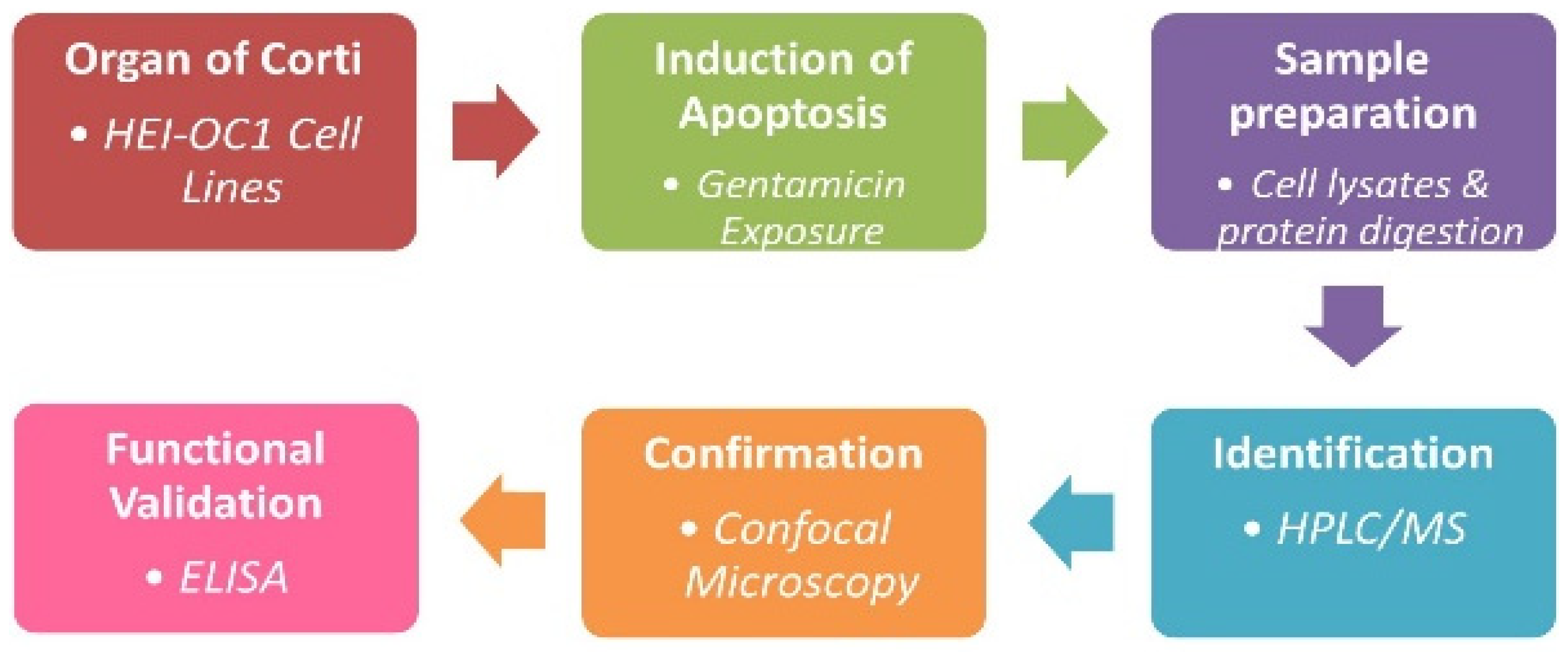

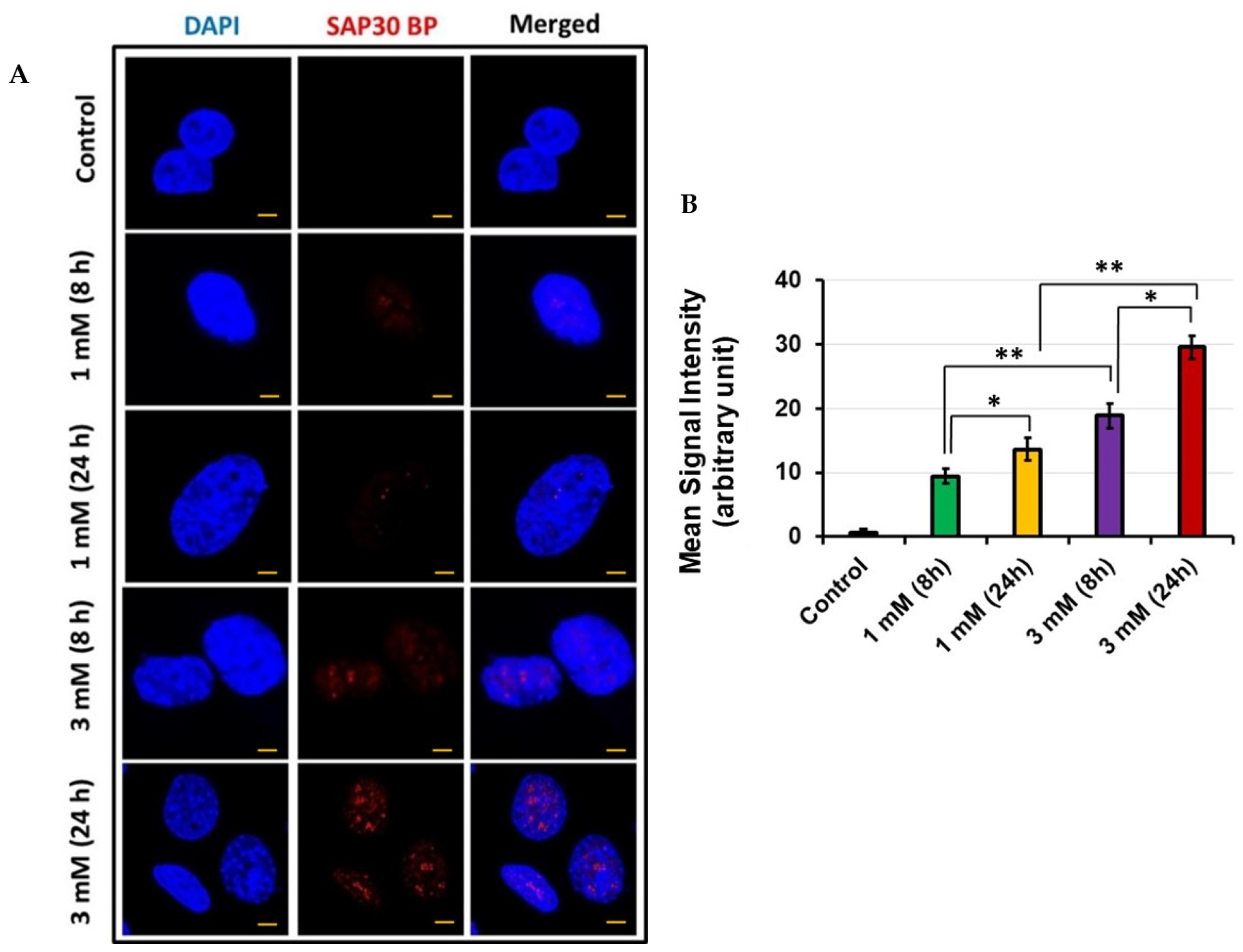
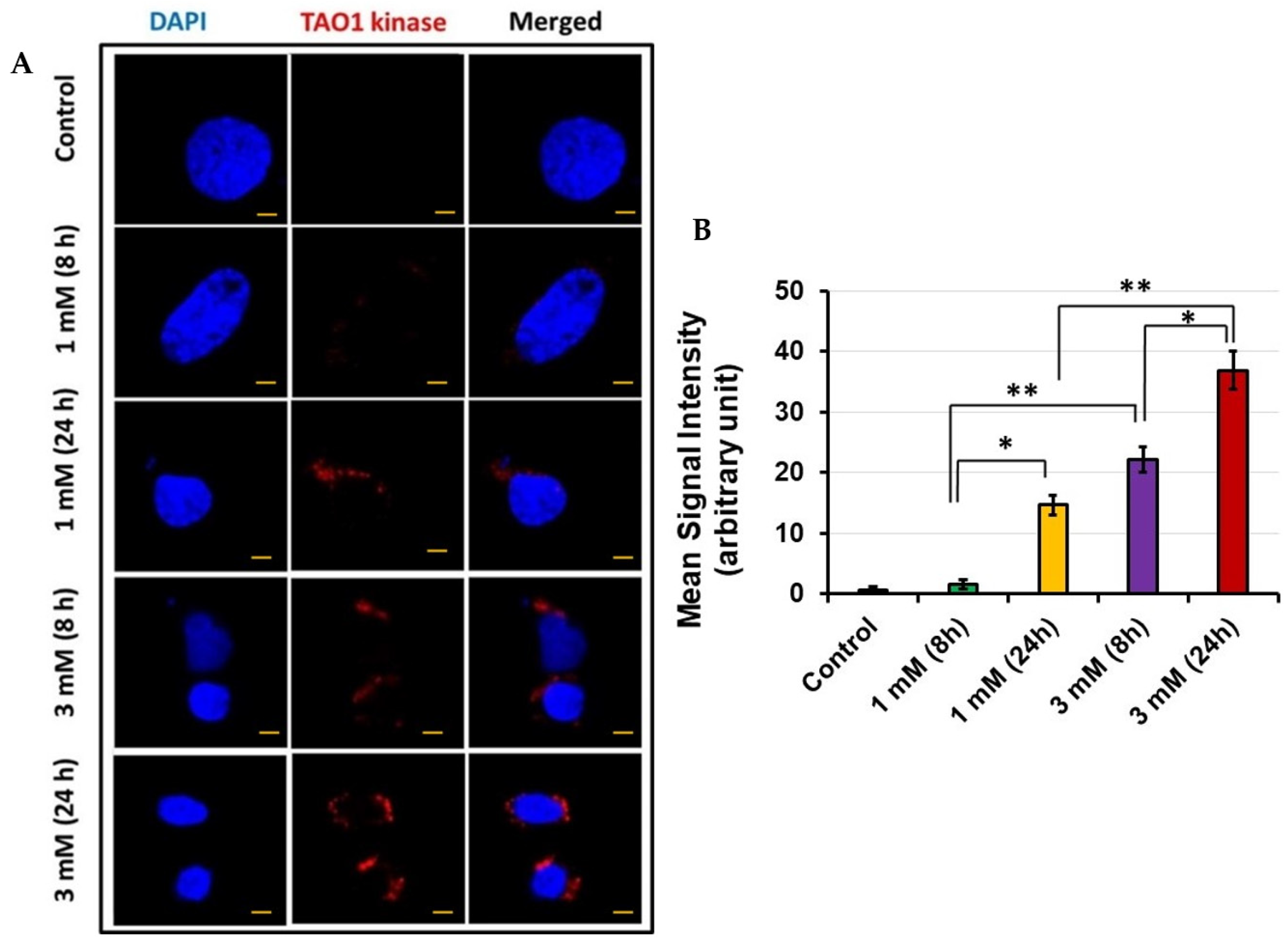
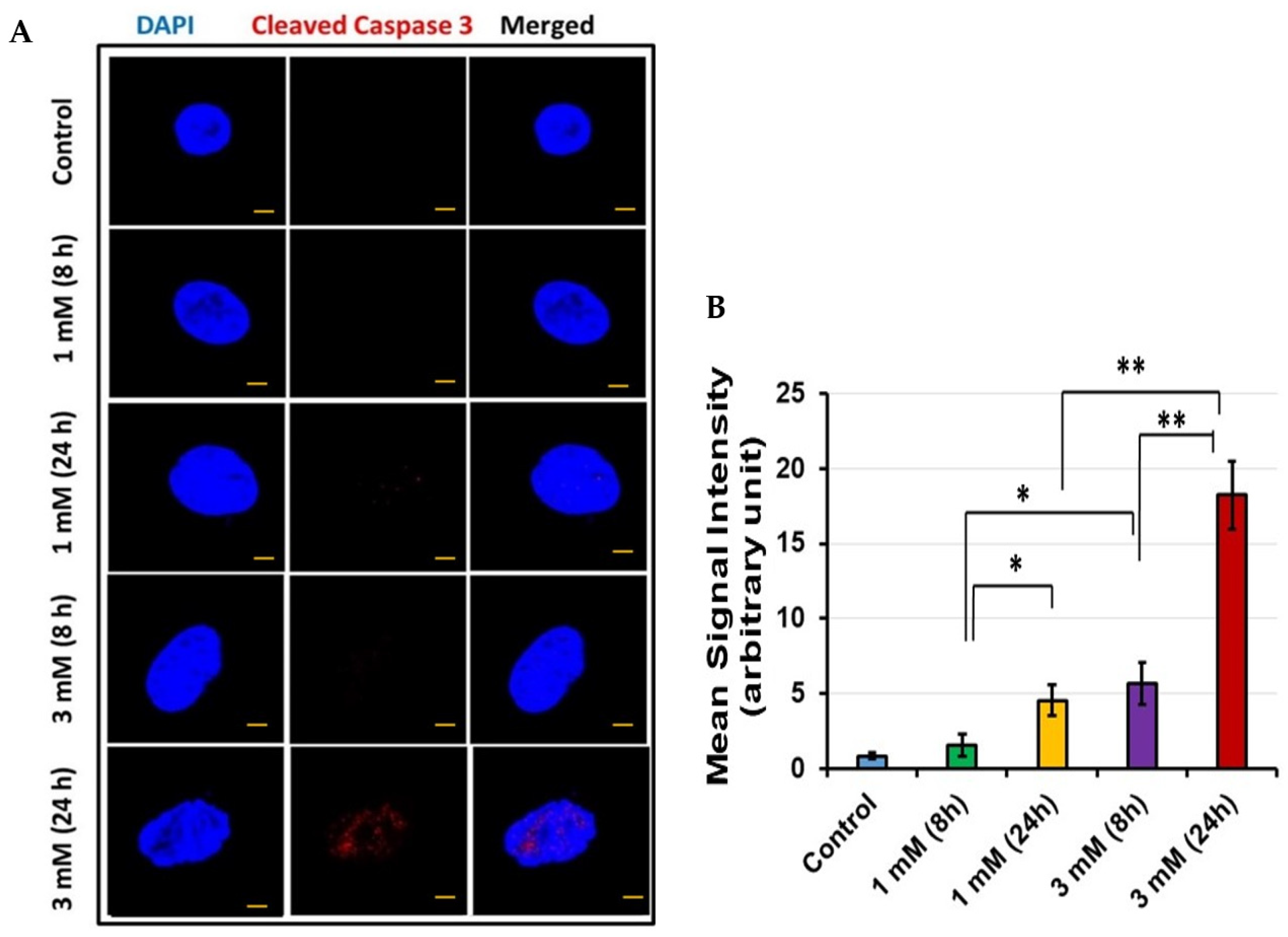
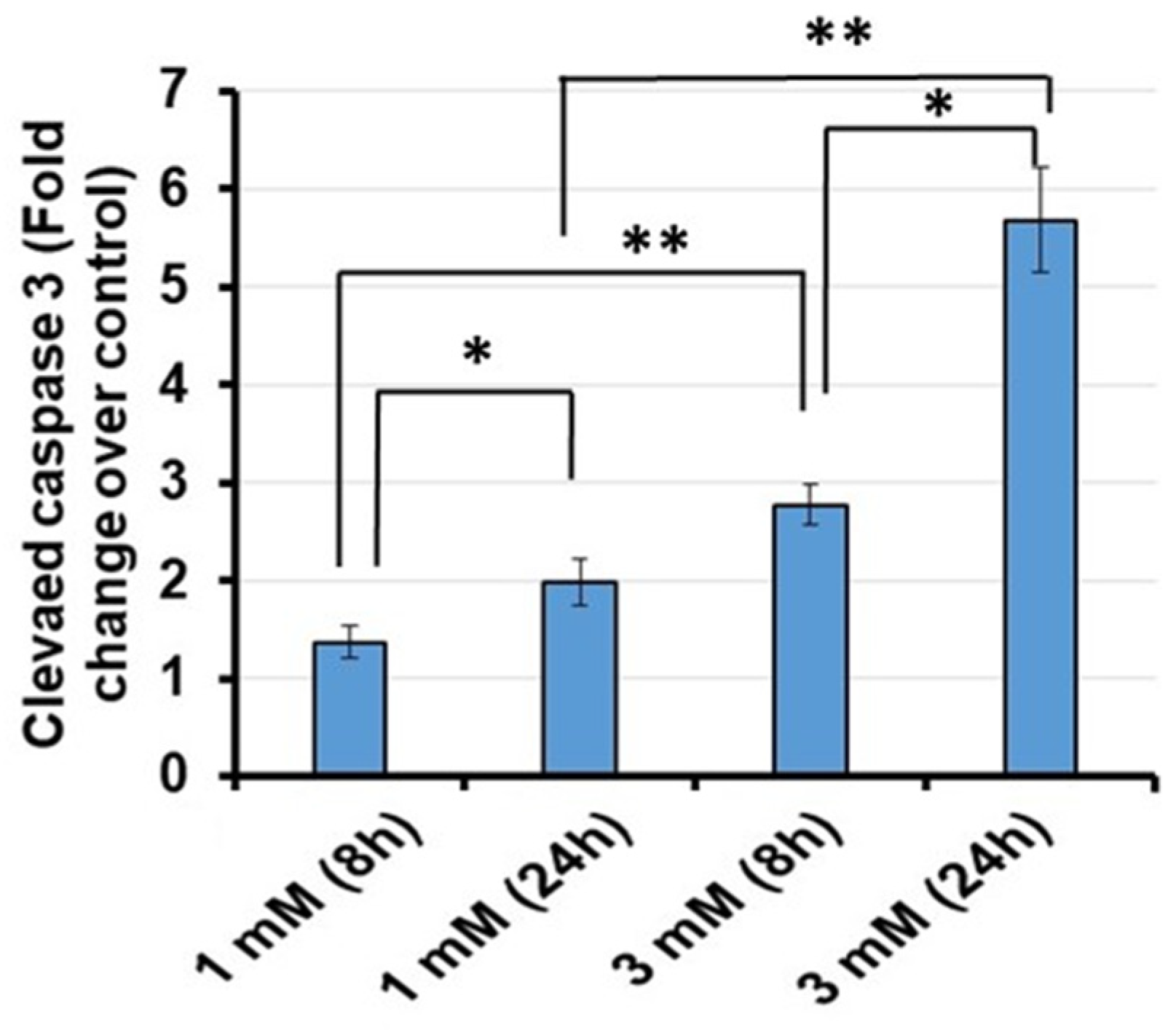
| Gene Names | 1 mM | 3 mM | Protein Names |
|---|---|---|---|
| Sap30bp Hcngp | 27 | 38 | SAP30-binding protein |
| Taok1 | 24 | 37 | TAO1 kinase |
| Mef2d | 20 | 37 | Myocyte-specific enhancer factor 2D |
| Bak1 Bak | 35 | 35 | Bcl-2 homologous antagonist/killer |
| Casp9 | 27 | 34 | Caspase-9 (Fragment) |
| Tpx2 | 33 | 32 | Targeting protein for Xklp2 |
| Map1s Mtap1s | 20 | 26 | Microtubule-associated protein 1S |
| Hip1r mKIAA0655 | 16 | 26 | MKIAA0655 protein (Fragment) |
| Gas2 Gas-2 | 28 | 24 | Growth arrest-specific protein 2 (GAS-2) |
| Polr2g | 18 | 23 | DNA-directed RNA polymerase II subunit |
| Tia1 Tia | 11 | 21 | Nucleolysin TIA-1 |
| Casp4 Casp11 Caspl Ich3 | 24 | 21 | Caspase-4 (CASP-4) |
| Fadd Mort1 | 11 | 20 | FAS-associated death domain protein |
| Bik Biklk | 28 | 18 | Bik protein |
| Ddit3 Chop Chop10 Gadd153 | 18 | 17 | DNA damage-inducible transcript 3 protein |
| Csnk2a1 Ckiia | 11 | 16 | Casein kinase II subunit alpha (CK II alpha) |
| Dap3 | 15 | 16 | 28S ribosomal protein S29, mitochondrial |
| Epo | 20 | 15 | Erythropoietin |
| Cyfip2 Kiaa1168 Pir121 | 14 | 15 | Cytoplasmic FMR1-interacting protein 2 |
| Pim3 | 13 | 13 | Serine/threonine-protein kinase pim-3 |
| Nsg1 NEEP21 | 11 | 12 | Neuronal vesicle trafficking protein 1 |
| Birc6 | 7 | 12 | UBIQUITIN_CONJUGAT_2 domain protein |
| Hip1r | 8 | 11 | Huntingtin-interacting protein 1 |
| Rock1 | 12 | 9 | Rho-associated protein kinase 1 |
| Fas | 7 | 9 | Fas |
| Bcl2l13 Mil1 | 18 | 8 | Bcl-2-like protein 13 (Bcl2-L-13) |
| Cckbr | 10 | 8 | Gastrin/cholecystokinin type B receptor |
Publisher’s Note: MDPI stays neutral with regard to jurisdictional claims in published maps and institutional affiliations. |
© 2022 by the authors. Licensee MDPI, Basel, Switzerland. This article is an open access article distributed under the terms and conditions of the Creative Commons Attribution (CC BY) license (https://creativecommons.org/licenses/by/4.0/).
Share and Cite
Davies, C.; Mittal, R.; Li, C.Y.; Marwede, H.; Bergman, J.; Hilton, N.; Mittal, J.; Bhattacharya, S.K.; Eshraghi, A.A. Identification of Target Proteins Involved in Cochlear Hair Cell Progenitor Cytotoxicity following Gentamicin Exposure. J. Clin. Med. 2022, 11, 4072. https://doi.org/10.3390/jcm11144072
Davies C, Mittal R, Li CY, Marwede H, Bergman J, Hilton N, Mittal J, Bhattacharya SK, Eshraghi AA. Identification of Target Proteins Involved in Cochlear Hair Cell Progenitor Cytotoxicity following Gentamicin Exposure. Journal of Clinical Medicine. 2022; 11(14):4072. https://doi.org/10.3390/jcm11144072
Chicago/Turabian StyleDavies, Camron, Rahul Mittal, Crystal Y. Li, Hannah Marwede, Jenna Bergman, Nia Hilton, Jeenu Mittal, Sanjoy K. Bhattacharya, and Adrien A. Eshraghi. 2022. "Identification of Target Proteins Involved in Cochlear Hair Cell Progenitor Cytotoxicity following Gentamicin Exposure" Journal of Clinical Medicine 11, no. 14: 4072. https://doi.org/10.3390/jcm11144072
APA StyleDavies, C., Mittal, R., Li, C. Y., Marwede, H., Bergman, J., Hilton, N., Mittal, J., Bhattacharya, S. K., & Eshraghi, A. A. (2022). Identification of Target Proteins Involved in Cochlear Hair Cell Progenitor Cytotoxicity following Gentamicin Exposure. Journal of Clinical Medicine, 11(14), 4072. https://doi.org/10.3390/jcm11144072









